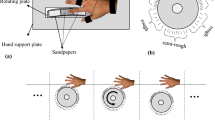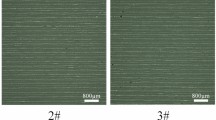Abstract
Friction forces between human fingertip and a Braille display were recorded simultaneously with electroencephalographic (EEG) signals related to the somatosensory cortex. The correlation between frictional stimuli and event-related EEG signals was analyzed. Raising and lowering the dots of the Braille display caused significant N50 and P110 waves in the event-related EEG signal, but variations in the force stimulus by a factor of two between different Braille pattern did not cause significant differences in the EEG responses related to early tactile processing. Raising and lowering the dots of the Braille display triggers a characteristic temporal development of friction due to viscoelastic skin relaxation.






Similar content being viewed by others
References
Adams, M.J., Briscoe, B.J., Johnson, S.A.: Friction and lubrication of human skin. Tribol. Lett. 26(3), 239–253 (2007)
Chen, S., Ge, S.R.: Experimental research on the tactile perception from fingertip skin friction. Wear 376, 305–314 (2017)
Crichton, M.L., Chen, X.F., Huang, H., Kendall, M.A.F.: Elastic modulus and viscoelastic properties of full thickness skin characterised at micro scales. Biomaterials 34(8), 2087–2097 (2013)
Darden, M.A., Schwartz, C.J.: Skin tribology phenomena associated with reading braille print: The influence of cell patterns and skin behavior on coefficient of friction. Wear 332, 734–741 (2015)
Forster, B., Eimer, M.: Vision and gaze direction modulate tactile processing in somatosensory cortex: evidence from event-related brain potentials. Exp. Brain Res. 165(1), 8–18 (2005)
Genna, C., Oddo, C.M., Fanciullacci, C., Chisari, C., Jorntell, H., Artoni, F., Micera, S.: Spatiotemporal dynamics of the cortical responses induced by a prolonged tactile stimulation of the human fingertips. Brain Topogr. 30(4), 473–485 (2017)
Gindrat, A.D., Chytiris, M., Balerna, M., Rouiller, E.M., Ghosh, A.: Use-dependent cortical processing from fingertips in touchscreen phone users. Curr. Biol. 25(1), 109–116 (2015)
Hashimoto, I.: Trigeminal evoked-potentials following brief air puff—enhanced signal-to-noise ratio. Ann. Neurol. 23(4), 332–338 (1988)
Hashimoto, I., Gatayama, T., Yoshikawa, K., Sasaki, M.: Somatosensory evoked potential correlates of psychophysical magnitude estimations for air-puff stimulation of the foot in man. Exp. Brain Res. 92(2), 318–325 (1992)
Hatwell, Y., Gentaz, E.: Early psychological studies on touch in France. In: Grunwald, M. (ed.) Human Haptic Perception, pp. 55–66. Birkhäuser, Basel (2008)
Hayward, V., Terekhov, A.V., Wong, S.C., Geborek, P., Bengtsson, F., Jrntell, H.: Spatio-temporal skin strain distributions evoke low variability spike responses in cuneate neurons. J. R. Soc. Interface 11(93), 20131015 (2014)
Hori, J., Okada, N.: Classification of tactile event-related potential elicited by braille display for brain-computer interface. Biocybern. Biomed. Eng. 37(1), 135–142 (2017)
Klocker, A., Wiertlewski, M., Theate, V., Hayward, V., Thonnard, J.L.: Physical factors influencing pleasant touch during tactile exploration. PLoS ONE 8(11), e79,085 (2013)
Li, W., Pang, Q., Jiang, Y.S., Zhai, Z.H., Zhou, Z.R.: Study of physiological parameters and comfort sensations during friction contacts of the human skin. Tribol. Lett. 48(3), 293–304 (2012)
Munoz, F., Reales, J.M., Sebastian, M.A., Ballesteros, S.: An electrophysiological study of haptic roughness: Effects of levels of texture and stimulus uncertainty in the p300. Brain Res. 1562, 59–68 (2014)
Nakazawa, N., Ikeura, R., Inooka, H.: Characteristics of human fingertips in the shearing direction. Biol. Cybern. 82(3), 207–214 (2000)
Oezguen, N., Schubert, K.J., Bergmann, R., Bennewitz, R., Strauss, D.J.: Relating tribological stimuli to somatosensory electroencephalographic responses. In: 2015 37th Annual International Conference of the IEEE Engineering in Medicine and Biology Society (EMBC), pp. 8115–8118 (2015)
Pailler-Mattei, C., Bec, S., Zahouani, H.: In vivo measurements of the elastic mechanical properties of human skin by indentation tests. Med. Eng. Phys. 30(5), 599–606 (2008)
Persson, B.N.J., Kovalev, A., Gorb, S.N.: Contact mechanics and friction on dry and wet human skin. Tribol. Lett. 50(1), 17–30 (2013)
Picton, T.: Human Auditory Evoked Potentials. Plural Publishing, San Diego (2010)
Platkiewicz, J., Lipson, H., Hayward, V.: Haptic edge detection through shear. Sci. Rep. 6, 23551 (2016)
Skedung, L., Arvidsson, M., Chung, J.Y., Stafford, C.M., Berglund, B., Rutland, M.W.: Feeling small: exploring the tactile perception limits. Sci. Rep. 3, 2617 (2013)
Strauss, D.J., Teuber, T., Steidl, G., Corona-Strauss, F.I.: Exploiting the self-similarity in erp images by nonlocal means for single-trial denoising. IEEE Trans. Neural Syst. Rehabil. Eng. 21(4), 576–583 (2013)
Wiertlewski, M., Hayward, V.: Mechanical behavior of the fingertip in the range of frequencies and displacements relevant to touch. J. Biomech. 45(11), 1869–1874 (2012)
Woodman, G.F.: A brief introduction to the use of event-related potentials in studies of perception and attention. Attent. Percept. Psychophys. 72(8), 2031–2046 (2010)
Acknowledgements
We acknowledge continuing support for this project by Eduard Arzt.
Author information
Authors and Affiliations
Corresponding author
Rights and permissions
About this article
Cite this article
Özgün, N., Strauss, D.J. & Bennewitz, R. Tribology of a Braille Display and EEG Correlates. Tribol Lett 66, 16 (2018). https://doi.org/10.1007/s11249-017-0969-7
Received:
Accepted:
Published:
DOI: https://doi.org/10.1007/s11249-017-0969-7




